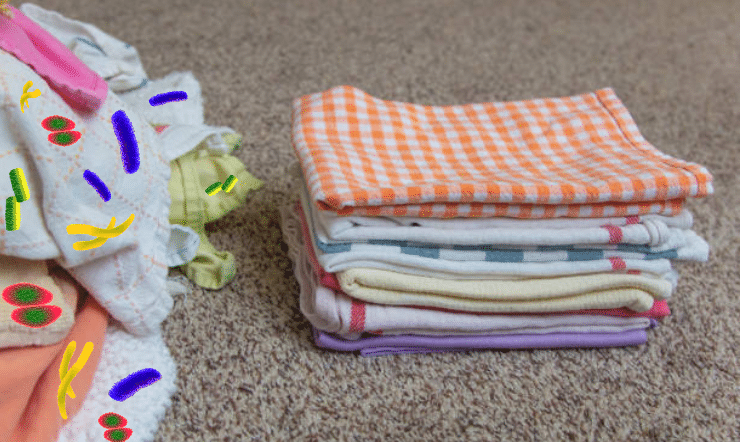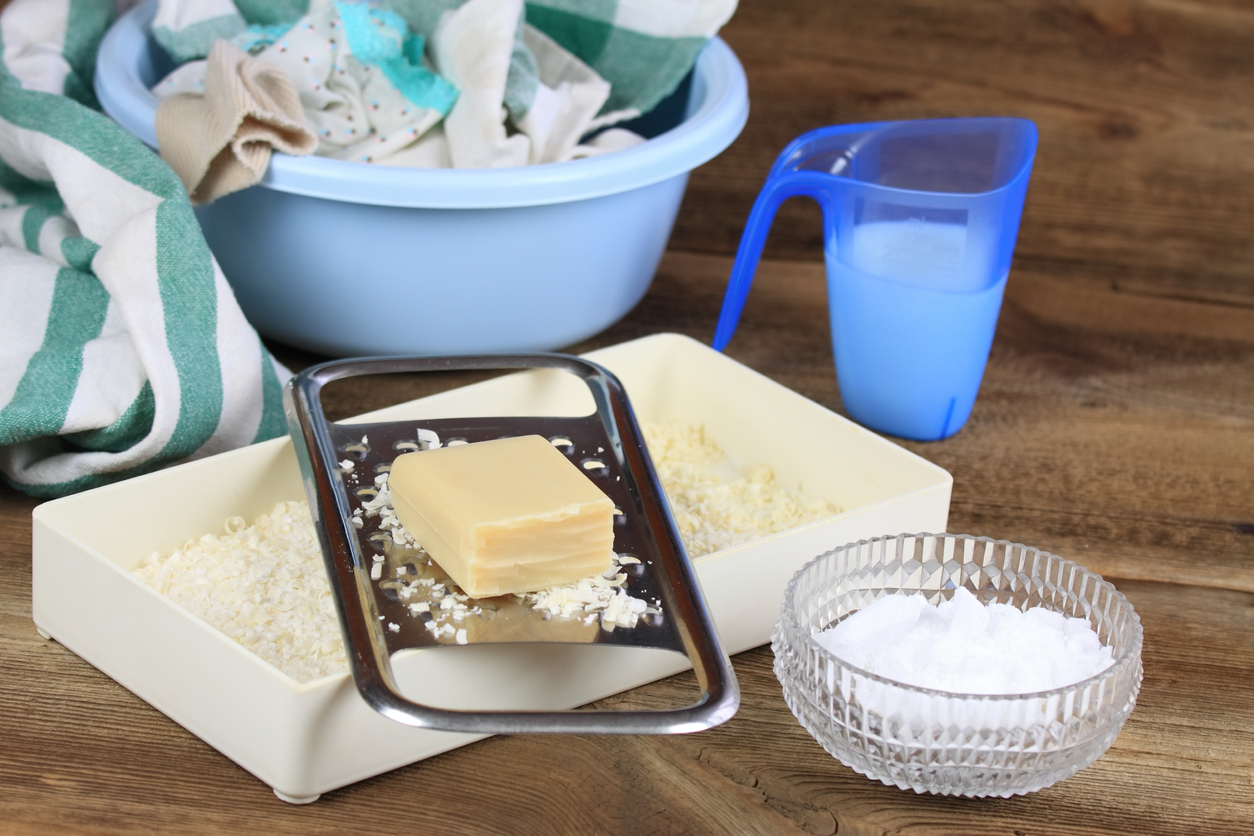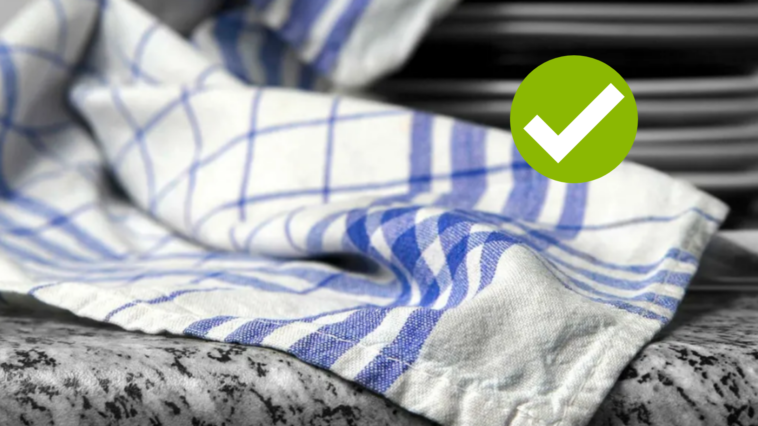Certainly, absorbent paper is very practical in the kitchen. However, it is not very ecological and for daily use, the classic multi-purpose cotton or linen tea towel remains the reference. In fact, we use it to dry dishes, dry our hands, wipe all surfaces with a cloth, etc. However, between humidity and food stains, dishcloths quickly become very dirty and stained breeding grounds for bacteria. Even after a very hot machine wash, you cannot always find an immaculate tea towel as on the first day. It’s not great in terms of hygiene… Here are some grandmother’s tips and good reflexes to finally know how to clean, disinfect and whiten your tea towels to perfection. With a few good maintenance rules, your household linen will last a long time and germs will not cross the threshold of the kitchen.
You will see that to stain, wash, whiten and disinfect your cloths, you will not need harmful bleach!
1) The right reflex to have with new tea towels
As with new clothes, it is obviously very important to wash new cloths. This makes it possible to remove chemical treatments and ensure their good hygiene. You don’t know who touched them before you after all! However, you may have already noticed that new cloths are still very stiff. They are in fact covered in primer, which prevents them from properly absorbing and wiping away. To remove this primer, the good reflex to have is to prepare a basin of lukewarm water with three handfuls of coarse salt. Then let each new cloth soak in it overnight. Your cloths will then be ready to use.
2) Good washing habits and frequencies

Of course, the frequency of washing will depend on how you use your dishcloths. To avoid food poisoning, it is generally necessary allow 2 to 3 days. However, it is better to favor daily washing in case of intensive use and it can be extended up to a week in case of limited use. And obviously, in the event of a stain, don’t wait to put the cloth in the dirty area. And finally, never leave a damp cloth balled up on the work surface. Make sure the dishcloths do not remain damp for an extended period of time, as moisture encourages the growth of bacteria. Let it dry if possible near a heat source (radiator, oven, tumble dryer, etc.), spread out or hung up to dry properly after each use.
3) Pretreat stubborn stains before washing
Ideally, a stain should be treated immediately as soon as it appears. To do this, nothing beats a real Marseille soap ! Rub your cube of soap on the still wet stain to form a crust. Then leave it on for an hour before lathering and putting the laundry in the washing machine. And if ironing can disinfect tea towels, avoid ironing over a stain, which would have the effect of permanently fixing it.

Good to know: You can also remove stains with beef gall soap or our stain remover before washing with baking soda and black soap.
4) Pre-wash very dirty dishcloths
You can pre-wash with hot water mixed with hydrogen peroxide. for disinfection of cloths. If you are more concerned about them detachin this case choose a basin of hot water with soda crystals (2/3-1/3) or washing soda (1/2 glass for 4l of water). Let your tea towels soak in this liquid for at least an hour before treating any remaining stains, draining them and putting them in the washing machine. Finally, to whiten them when they turn gray and restore their shine, use percarbonate of soda or a little dishwasher detergent in a basin of very hot water. This provides very effective whitening.
5) Machine wash!

You can use both powder and liquid detergent, preferably with bleaching agents. A cup of bicarbonate or ½ glass of ammonia can be added to better eliminate stains if necessary. On the other hand, the washing temperature is very important! Indeed, at 40°C, microbes are not destroyed. As with the rest of your household linen, it is better to set your washing machine to at least 60°C for disinfection of laundry. This will be more than enough, especially if you have pre-washed and stain removed. In the case of white cotton or linen rags which need a major “facelift”, we can however rise to 90°C. Above all, don’t hesitate to add sheets and towels to complete the machine without saturating it with laundry. It is indeed necessary to allow good rinsing of the dirt!
And adding fabric softener, good or bad idea?
Fabric softener often contains chemicals and fragrances that can leave residue on dish towels. However, as with towels, these residues can interfere with the absorption effectiveness of dishclothswhich is crucial when it comes to wiping dishes or surfaces. In addition, dishcloths can be used to dry kitchen utensils and dishes. Softener residue could then potentially contaminate food. It is therefore better to stick to simpler washing methods, without chemicals, and especially without adding fabric softener.
However, if adding fabric softener is important to you, you might consideruse more natural and hypoallergenic products. You can also opt for gentler alternatives. This is the case with white vinegar which can also act as a natural fabric softener without leaving harmful residue. You can infuse plants (mint, lavender, etc.) or citrus peels to provide a good smell without risking polluting your kitchen. In addition, this maintenance product helps to loosen and eliminate unpleasant damp odors on your hand towel and kitchen towel!
Some tips for keeping your tea towels clean for longer…

Assign specific dishcloths to particular tasks : one for wiping hands, another for polishing kitchen surfaces and finally a last one for drying dishes. Never mix them or use them interchangeably. This can actually help reduce the spread of bacteria and prolong the cleanliness of each dishcloth. You can easily avoid confusing them by storing them in different places or adopting a color code. This simple hygiene measure will also prevent your tea towels from becoming very heavily stained. For example, you can reserve the darker ones for cleaning surfaces. This will reduce the risk of stubborn and visible stains!


